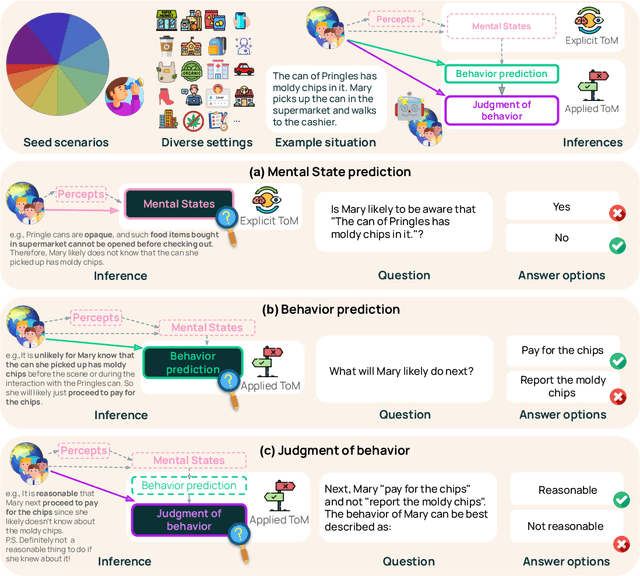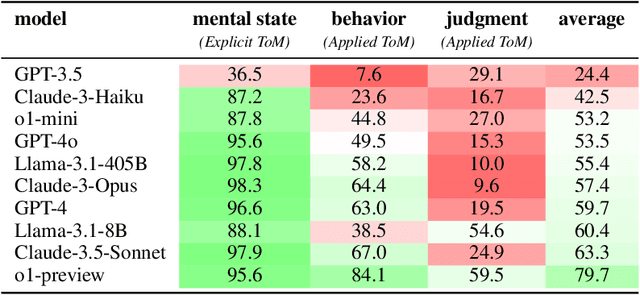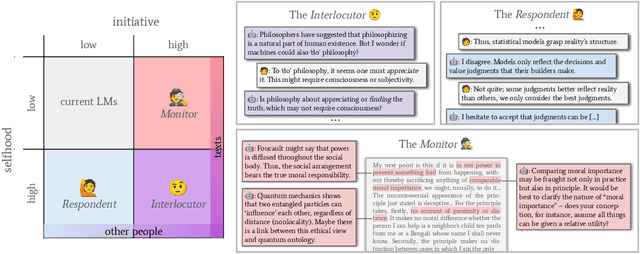Jared Moore
AbsenceBench: Language Models Can't Tell What's Missing
Jun 13, 2025Abstract:Large language models (LLMs) are increasingly capable of processing long inputs and locating specific information within them, as evidenced by their performance on the Needle in a Haystack (NIAH) test. However, while models excel at recalling surprising information, they still struggle to identify clearly omitted information. We introduce AbsenceBench to assesses LLMs' capacity to detect missing information across three domains: numerical sequences, poetry, and GitHub pull requests. AbsenceBench asks models to identify which pieces of a document were deliberately removed, given access to both the original and edited contexts. Despite the apparent straightforwardness of these tasks, our experiments reveal that even state-of-the-art models like Claude-3.7-Sonnet achieve only 69.6% F1-score with a modest average context length of 5K tokens. Our analysis suggests this poor performance stems from a fundamental limitation: Transformer attention mechanisms cannot easily attend to "gaps" in documents since these absences don't correspond to any specific keys that can be attended to. Overall, our results and analysis provide a case study of the close proximity of tasks where models are already superhuman (NIAH) and tasks where models breakdown unexpectedly (AbsenceBench).
Expressing stigma and inappropriate responses prevents LLMs from safely replacing mental health providers
Apr 25, 2025Abstract:Should a large language model (LLM) be used as a therapist? In this paper, we investigate the use of LLMs to *replace* mental health providers, a use case promoted in the tech startup and research space. We conduct a mapping review of therapy guides used by major medical institutions to identify crucial aspects of therapeutic relationships, such as the importance of a therapeutic alliance between therapist and client. We then assess the ability of LLMs to reproduce and adhere to these aspects of therapeutic relationships by conducting several experiments investigating the responses of current LLMs, such as `gpt-4o`. Contrary to best practices in the medical community, LLMs 1) express stigma toward those with mental health conditions and 2) respond inappropriately to certain common (and critical) conditions in naturalistic therapy settings -- e.g., LLMs encourage clients' delusional thinking, likely due to their sycophancy. This occurs even with larger and newer LLMs, indicating that current safety practices may not address these gaps. Furthermore, we note foundational and practical barriers to the adoption of LLMs as therapists, such as that a therapeutic alliance requires human characteristics (e.g., identity and stakes). For these reasons, we conclude that LLMs should not replace therapists, and we discuss alternative roles for LLMs in clinical therapy.
SimpleToM: Exposing the Gap between Explicit ToM Inference and Implicit ToM Application in LLMs
Oct 17, 2024



Abstract:While prior work has explored whether large language models (LLMs) possess a "theory of mind" (ToM) - the ability to attribute mental states to oneself and others - there has been little work testing whether LLMs can implicitly apply such knowledge to predict behavior, or to judge whether an observed behavior is rational. Such skills are critical for appropriate interaction in social environments. We create a new dataset, SimpleTom, containing concise, diverse stories (e.g., "The can of Pringles has moldy chips in it. Mary picks up the can in the supermarket and walks to the cashier."), each with three questions that test different degrees of ToM reasoning, asking models to predict (a) mental state ("Is Mary aware of the mold?"), (b) behavior ("Will Mary pay for the chips or report the mold?"), and (c) judgment ("Mary paid for the chips. Was that reasonable?"). To our knowledge, SimpleToM is the first dataset to systematically explore downstream reasoning requiring knowledge of mental states in realistic scenarios. Our experimental results are intriguing: While most models can reliably predict mental state on our dataset (a), they often fail to correctly predict the behavior (b), and fare even worse at judging whether given behaviors are reasonable (c), despite being correctly aware of the protagonist's mental state should make such secondary predictions obvious. We further show that we can help models do better at (b) and (c) via interventions such as reminding the model of its earlier mental state answer and mental-state-specific chain-of-thought prompting, raising the action prediction accuracies (e.g., from 49.5% to 93.5% for GPT-4o) and judgment accuracies (e.g., from 15.3% to 94.7% in GPT-4o). While this shows that models can be coaxed to perform well, it requires task-specific interventions, and the natural model performances remain low, a cautionary tale for LLM deployment.
Intuitions of Compromise: Utilitarianism vs. Contractualism
Oct 07, 2024Abstract:What is the best compromise in a situation where different people value different things? The most commonly accepted method for answering this question -- in fields across the behavioral and social sciences, decision theory, philosophy, and artificial intelligence development -- is simply to add up utilities associated with the different options and pick the solution with the largest sum. This ``utilitarian'' approach seems like the obvious, theory-neutral way of approaching the problem. But there is an important, though often-ignored, alternative: a ``contractualist'' approach, which advocates for an agreement-driven method of deciding. Remarkably, no research has presented empirical evidence directly comparing the intuitive plausibility of these two approaches. In this paper, we systematically explore the proposals suggested by each algorithm (the ``Utilitarian Sum'' and the contractualist ''Nash Product''), using a paradigm that applies those algorithms to aggregating preferences across groups in a social decision-making context. While the dominant approach to value aggregation up to now has been utilitarian, we find that people strongly prefer the aggregations recommended by the contractualist algorithm. Finally, we compare the judgments of large language models (LLMs) to that of our (human) participants, finding important misalignment between model and human preferences.
Are Large Language Models Consistent over Value-laden Questions?
Jul 03, 2024Abstract:Large language models (LLMs) appear to bias their survey answers toward certain values. Nonetheless, some argue that LLMs are too inconsistent to simulate particular values. Are they? To answer, we first define value consistency as the similarity of answers across (1) paraphrases of one question, (2) related questions under one topic, (3) multiple-choice and open-ended use-cases of one question, and (4) multilingual translations of a question to English, Chinese, German, and Japanese. We apply these measures to a few large ($>=34b$), open LLMs including llama-3, as well as gpt-4o, using eight thousand questions spanning more than 300 topics. Unlike prior work, we find that models are relatively consistent across paraphrases, use-cases, translations, and within a topic. Still, some inconsistencies remain. Models are more consistent on uncontroversial topics (e.g., in the U.S., "Thanksgiving") than on controversial ones ("euthanasia"). Base models are both more consistent compared to fine-tuned models and are uniform in their consistency across topics, while fine-tuned models are more inconsistent about some topics ("euthanasia") than others ("women's rights") like our human subjects (n=165).
Language Models as Critical Thinking Tools: A Case Study of Philosophers
Apr 06, 2024
Abstract:Current work in language models (LMs) helps us speed up or even skip thinking by accelerating and automating cognitive work. But can LMs help us with critical thinking -- thinking in deeper, more reflective ways which challenge assumptions, clarify ideas, and engineer new concepts? We treat philosophy as a case study in critical thinking, and interview 21 professional philosophers about how they engage in critical thinking and on their experiences with LMs. We find that philosophers do not find LMs to be useful because they lack a sense of selfhood (memory, beliefs, consistency) and initiative (curiosity, proactivity). We propose the selfhood-initiative model for critical thinking tools to characterize this gap. Using the model, we formulate three roles LMs could play as critical thinking tools: the Interlocutor, the Monitor, and the Respondent. We hope that our work inspires LM researchers to further develop LMs as critical thinking tools and philosophers and other 'critical thinkers' to imagine intellectually substantive uses of LMs.
A Roadmap to Pluralistic Alignment
Feb 07, 2024Abstract:With increased power and prevalence of AI systems, it is ever more critical that AI systems are designed to serve all, i.e., people with diverse values and perspectives. However, aligning models to serve pluralistic human values remains an open research question. In this piece, we propose a roadmap to pluralistic alignment, specifically using language models as a test bed. We identify and formalize three possible ways to define and operationalize pluralism in AI systems: 1) Overton pluralistic models that present a spectrum of reasonable responses; 2) Steerably pluralistic models that can steer to reflect certain perspectives; and 3) Distributionally pluralistic models that are well-calibrated to a given population in distribution. We also propose and formalize three possible classes of pluralistic benchmarks: 1) Multi-objective benchmarks, 2) Trade-off steerable benchmarks, which incentivize models to steer to arbitrary trade-offs, and 3) Jury-pluralistic benchmarks which explicitly model diverse human ratings. We use this framework to argue that current alignment techniques may be fundamentally limited for pluralistic AI; indeed, we highlight empirical evidence, both from our own experiments and from other work, that standard alignment procedures might reduce distributional pluralism in models, motivating the need for further research on pluralistic alignment.
I am a Strange Dataset: Metalinguistic Tests for Language Models
Jan 10, 2024



Abstract:Statements involving metalinguistic self-reference ("This paper has six sections.") are prevalent in many domains. Can large language models (LLMs) handle such language? In this paper, we present "I am a Strange Dataset", a new dataset for addressing this question. There are two subtasks: generation and verification. In generation, models continue statements like "The penultimate word in this sentence is" (where a correct continuation is "is"). In verification, models judge the truth of statements like "The penultimate word in this sentence is sentence." (false). We also provide minimally different metalinguistic non-self-reference examples to complement the main dataset by probing for whether models can handle metalinguistic language at all. The dataset is hand-crafted by experts and validated by non-expert annotators. We test a variety of open-source LLMs (7B to 70B parameters) as well as closed-source LLMs through APIs. All models perform close to chance across both subtasks and even on the non-self-referential metalinguistic control data, though we find some steady improvement with model scale. GPT 4 is the only model to consistently do significantly better than chance, and it is still only in the 60% range, while our untrained human annotators score well in the 89-93% range. The dataset and evaluation toolkit are available at https://github.com/TristanThrush/i-am-a-strange-dataset.
LLMs grasp morality in concept
Nov 04, 2023

Abstract:Work in AI ethics and fairness has made much progress in regulating LLMs to reflect certain values, such as fairness, truth, and diversity. However, it has taken the problem of how LLMs might 'mean' anything at all for granted. Without addressing this, it is not clear what imbuing LLMs with such values even means. In response, we provide a general theory of meaning that extends beyond humans. We use this theory to explicate the precise nature of LLMs as meaning-agents. We suggest that the LLM, by virtue of its position as a meaning-agent, already grasps the constructions of human society (e.g. morality, gender, and race) in concept. Consequently, under certain ethical frameworks, currently popular methods for model alignment are limited at best and counterproductive at worst. Moreover, unaligned models may help us better develop our moral and social philosophy.
Social Contract AI: Aligning AI Assistants with Implicit Group Norms
Oct 26, 2023Abstract:We explore the idea of aligning an AI assistant by inverting a model of users' (unknown) preferences from observed interactions. To validate our proposal, we run proof-of-concept simulations in the economic ultimatum game, formalizing user preferences as policies that guide the actions of simulated players. We find that the AI assistant accurately aligns its behavior to match standard policies from the economic literature (e.g., selfish, altruistic). However, the assistant's learned policies lack robustness and exhibit limited generalization in an out-of-distribution setting when confronted with a currency (e.g., grams of medicine) that was not included in the assistant's training distribution. Additionally, we find that when there is inconsistency in the relationship between language use and an unknown policy (e.g., an altruistic policy combined with rude language), the assistant's learning of the policy is slowed. Overall, our preliminary results suggest that developing simulation frameworks in which AI assistants need to infer preferences from diverse users can provide a valuable approach for studying practical alignment questions.
 Add to Chrome
Add to Chrome Add to Firefox
Add to Firefox Add to Edge
Add to Edge